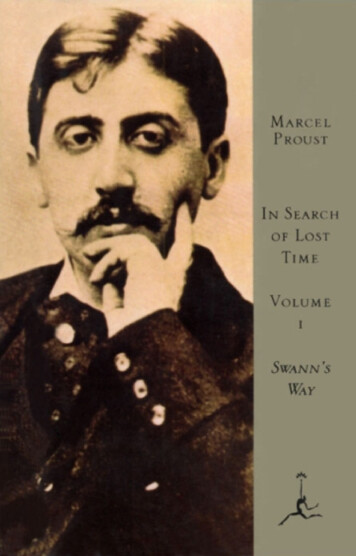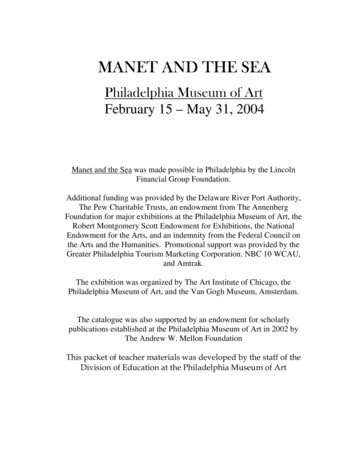
Transcription
Marcel ProustSwann’s WayCLASSICFICTIONRead by NevilleJasonMODERNCLASSICSNA305312DR E M E M B R A N C E O F T H I N G S PA S T I
123456789101112OvertureFor a long time I used to go to bed early.The ritual of the ‘good night’ kissSwann and the middle class casteOur social personality is created My foreboding – the evening ritual in dangerI never took my eyes off my mother.A desperate stratagemAgitation and desperate measuresCaught in the light of my father’s candle‘Many years have passed ’The petites madeleines And suddenly the memory 276:10
d in long shadows of memoryFrançoise and Aunt LéonieM. Legrandin, the engineerEulalie, the ‘energetic, deaf spinster’My last visit to Uncle AdolpheReading in the sulightMy friend Bloch and literary conversationAunt Léonie with Françoise and EulalieThe kitchen maid’s confinement and a waking dreamM. Vinteuil, the music masterFrançoise – ‘A colonel in the kitchen’‘Alas – we have had to alter our opinion ’The two ways‘The whole path throbbing ’Mlle Vinteuil and her friendMy aunt’s last illnessWatching from the bushesThe Guermantes WayThe zone of 2:417:3415:325:429:208:403:1910:013:549:56Total time: 3:50:103
Marcel Proust at Illiers4
Marcel ProustSwann’s WayGuermantes I (The Guermantes Way I) in1920; Le Côté de Guermantes II and Sodomeet Gomorrhe (Cities of the Plain I) in 1921;Sodome et Gomorrhe II in 1922; LaPrisonnière (The Captive) in 1923; AlbertineDisparue (The Sweet Cheat Gone) in 1925;Le Temps Retrouvé (Time Regained) in 1927.Proust was obliged to publish Swann’sWay at his own expense, and even after ithad appeared he had trouble finding apublisher for the next volume A l’Ombredes Jeunes Filles en Fleurs. However, when itappeared in 1918 it received considerableacclaim, and was awarded the Prix Goncourtthe following year.By the time Proust died, on November18, 1922, the first four parts of the cycle hadbeen published, leaving the others to appearposthumously. The English translations byC.K. Scott Moncrieff, from which thisabridged version has been prepared, werepublished between 1922 and 1930.In Remembrance of Things Past, theminuteness of Proust’s observation, thedepth of his psychological understandingand the vividness of his descriptive powersMarcel Proust was born on July 10, 1871,the son of a prosperous Parisian professor ofmedicine and a Jewish mother.Although convinced from an early age ofhis calling as a writer, Proust was riddledwith self-doubt and wrote relatively little atthe beginning of his career. For a time hewas associated with a group of intellectualswho produced the cultural review La RevueBlanche. His life was that of a dilettante, hismilieu the fashionable Paris drawing room,and it was against this background that heset a number of stories. He was a greatadmirer of John Ruskin and translatedseveral of his works into French. It was notuntil Proust’s health began to fail around1902, forcing him to lead a retired andsolitary life, that he embarked on his greatwork A la Recherche du Temps Perdu(Remembrance of Things Past) of whichSwann’s Way forms the first part.This long cycle of autobiographical novelswas published in eight sections: Du Côtéde Chez Swann (Swann’s Way) in 1913; Al’Ombre des Jeunes Filles en Fleurs (WithinA Budding Grove) in 1918; Le Côté de5
have combined to create one of the mostpoetic and magical works in all literature.In Swann’s Way the narrator, in theperson of the author, introduces us to thehighly sensitive and imaginative child hewas; to the mother he loved so passionately,and from whom to be parted was suchagony; and to his father who, althoughloving in his way, was incapable ofunderstanding the emotional behaviour ofhis nervous and delicate child.The little village of Combray, to whichMarcel’s family travelled regularly from Paristo spend their holidays at his great aunt’shouse, is the setting for these childhoodmemories. Here we meet his other relativesin a succession of richly-drawn portraits; hisgrandmother whose passion for naturedrives her to run up and down the gardenpaths in the pouring rain; his somewhat‘common’ great-aunt who takes everyopportunity of putting down her morerefined sister-in-law; his two spinster aunts,grown deaf through lack of interest in thedinner table conversations; and Aunt Leonie,who has retired permanently to her bed,from whence she learns, by observingthrough her window the comings andgoings in the street below, every detail of thelives of the village’s inhabitants.The family’s neighbours also attract theinterest of the precocious Marcel, whosehighly developed powers of observationpierce through their urbane exteriors tothe pretensions and hypocrisy beneath –M. Legrandin, declared arch-enemy ofsnobbery, who cuts off Marcel and his familywhen he is in the company of granderfolk; M. Vinteuil, who condemns Swann’s‘unfortunate’ marriage, while turning a blindeye to his daughter’s love affair with an olderwoman; and Swann himself, who disparagesthe emptiness of high society while devotinghis life to parties and balls.Proust presents these characters with adepth of understanding of the humanpsyche which links him to another greatfigure of his time, Sigmund Freud. Proust,like Freud, understood the power of the pastto influence the present. His search for hisformer self is part of the process ofunderstanding the person he has become.For Proust, the two ‘Ways’, Swann’s‘Way’ and the Guermantes ‘Way’, differentdirections taken by the family for theirregular country walks, are more than meregeographical designations. Through thethoughts, sensations and memories theyinvoke, each comes to represent a differentaspect of his life, another ‘way’ of being.6
The AuthorMarcel Proust was born on July 10, 1871.His father, a distinguished professor ofmedicine, was from a Catholic family, whilehis mother was Jewish. Although intent onbecoming a writer from an early age, Proustwas riddled with self-doubt.During his twenties he co-founded ashort-lived review, Le Banquet, contributedto La Revue Blanche and had his first bookpublished in 1896, a collection of essaysentitled Les Plaisirs et les Jours.He became an enthusiastic admirer ofRuskin and translated his Bible of Amiensand Sesame and Lilies into French. A novel,Jean Santeuil, which was the precursorof Remembrance of Things Past, wasabandoned, and eventually published longafter Proust’s death, in 1954.For much of his youth Proust led thelife of a man about town, frequentingfashionable Paris drawing rooms and literarysalons, which were to form the backgroundof a number of his early stories andsketches, and subsequently of Remembranceof Things Past.The death of his adored mother in1905 resulted in a nervous collapseand aggravated his chronic asthma andinsomnia. But despite his grief and the senseof loss from which he never recovered, hismother’s death freed him with regard to hishomosexual emotional life, and allowed himBut no less memorable than thephilosophical and social observations tobe found in Remembrance of Things Pastare the rhapsodic and minutely observeddescriptions of nature, in particular thehawthorn and lilac trees which filled thewriter’s youthful soul with such passionatelove.Like all great works, Swann’s Way iscapable of many interpretations, and for thisabridged version it has been necessary tocurtail some of the more discursive passages.However, the complete text is alwaysavailable for the interested reader, and aspoken version has the advantage that thelistener may be able to detect an echo,however faint, of the author’s own uniquevoice, travelling towards him across theyears. For as Marcel Proust knew, art has thepower to conquer time.Notes by Neville Jason7
to address homosexuality in his writing,albeit in a manner which treated suchexperiences as happening to others ratherthan to himself.In 1907 he moved into an apartment inthe Boulevard Haussmann where, in thebedroom which he had had lined with corkto keep out noise, he embarked upon hisgreat work A la Recherche du Temps Perdu(Remembrance of Things Past).This long autobiographical cycle wasoriginally published in eight sections: DuCôté de Chez Swann (Swann’s Way) in1913; A L’Ombre des Jeunes Filles en Fleurs(Within a Budding Grove) in 1918; Le Côtéde Guermantes I (The Guermantes Way I) in1920; Le Côté de Guermantes II and Sodomet Gomorrhe I (Cities of the Plain I) in 1921;Sodom et Gomorrhe II in 1922; LaPrisonnière (The Captive) in 1923; AlbertineDisparue (The Sweet Cheat Gone) in 1925;Le Temps Retrouvé (Time Regained) in 1927.Proust was obliged to publish Swann’sWay at his own expense, and even after ithad appeared, had trouble finding apublisher for the next part, A L’Ombre desJeunes Filles en Fleurs. However, when itappeared in 1918 it received considerableacclaim, and was awarded the Prix Goncourtthe following year.By the time Proust died, on November18, 1922, the first four parts of thecycle had been published, leaving the othersto appear posthumously. The Englishtranslation from which this abridged versionhas been prepared was made by C.K. ScottMoncrieff.Notes by Neville Jason8
The music on this recording is taken from theNAXOS and MARCO POLO cataloguesFAURE NOCTURNES Nos. 1–6,THEME & VARIATIONS, Op. 73John Martin, Piano8.550794NOCTURNES Nos. 7–13, PRELUDES, Op. 103, Nos. 3&9TRIOS ROMANCES SANS PAROLES, Op. 17John Martin, Piano8.550795CHABRIER PIANO WORKS VOL. 1Georges Rabol8.553009DAVID LES BRISES D’ORIENT/LES MINARETSDaniel Blumenthal, Piano8.223376Cover picture: The Train in the Country by Claude Monet.Courtesy of The Bridgeman Art Library, London.9
Other Marcel Proust works on Naxos AudioBooksSwann in Love (Proust) 3CD/MCread by Neville JasonWithin a Budding Grove (Part I) (Proust) 3CDread by Neville JasonWithin a Budding Grove (Part II) (Proust) 3CD/MCread by Neville JasonThe Guermantes Way (Part I) (Proust) 3CD/MCread by Philip Madoc with Neville JasonThe Guermantes Way (Part II) (Proust) 3CD/MCread by Neville JasonSodom and Gomorrah (Part I) (Proust) 3CD/MCread by Neville JasonSodom and Gomorrah (Part II) (Proust) 3CD/MCread by Neville JasonThe Captive (Part I) (Proust) 3CD/MCread by Neville JasonThe Captive (Part II) (Proust) 3CD/MCread by Neville JasonThe Fugitive (Proust) 3CD/MCread by Neville JasonTime Regained (Proust) 3CD/MCread by Neville 112/4NA322012/4
Remembrance of Things Past – Box Set (Proust) 39CDread by Neville Jason – NAX2531211
Swann’s WayRead by Neville JasonSwann’s Way forms the first part of Marcel Proust’s magnificentautobiographical cycle Remembrance of Things Past. Here, Proust’s vision,psychological understanding and vivid powers of description combine to createone of the most poetic and magical works in all literature. For lovers of theoriginal text there are new delights to be found in this audiobook version, whilethose discovering the work for the first time may be surprised to find it soaccessible.CD ISBN:978-962-634-053-0View our catalogue online atwww.naxosaudiobooks.comALL RIGHTS RESERVED. UNAUTHORISED PUBLIC PERFORMANCE,BROADCASTING AND COPYING OF THESE COMPACT DISCS PROHIBITED.p 1995 NAXOS AudioBooks Ltd. 1995 NAXOS AudioBooks Ltd.Made in Germany.Neville Jason trained at RADA where he was awarded theDiction Prize by Sir John Gielgud. He has worked with the EnglishStage Co., the Old Vic Company and the RSC as well as in filmsand musicals. In television he has appeared in popular serials suchas Maigret, Emergency Ward 10 and Dr Who, as well as playingclassical roles such as Orestes and Horatio. Formerly a member ofthe BBC Radio Drama Co., he is frequently to be heard on radio.Abridged by Neville Jason. Produced by Nicolas SoamesEngineer (speech) and Post-production: Simon Weir,The Classical Recording CompanyMarcel ProustTotal time3:50:10
3 Combray Decked in long shadows of memory 6:43 Françoise and Aunt Léonie 5:37 M. Legrandin, the engineer 2:48 Eulalie, the 'energetic, deaf spinster' 6:15 My last visit to Uncle Adolphe 11:53 Reading in the sulight 4:47 My friend Bloch and literary conversation 11:22 Aunt Léonie with Françoise and Eulalie 12:19 The kitchen maid's confinement and a waking dream 4:09










